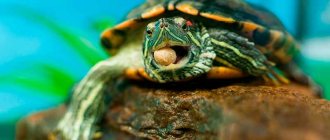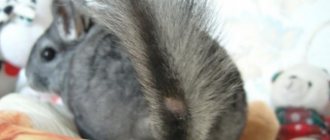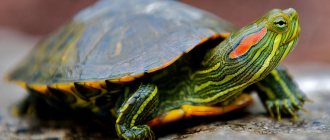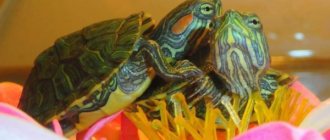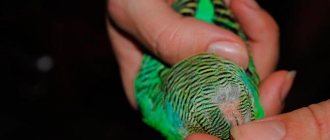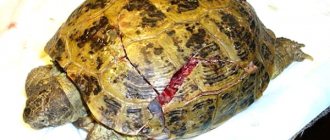The owner of a red-eared slider begins to feel anxious at the slightest change in the behavior of his pet, especially when the reptile refuses to eat. Some cases are completely safe and the animal’s health is not in danger.
In order to understand the situation, you should determine the cause that led to this condition and, if possible, begin to eliminate it. Not always independent intervention can be beneficial.
In order not to harm or worsen the situation, it is best to consult with specialists or experienced owners.
How to determine if your pet is hibernating
It is quite difficult to distinguish hibernation from death if you do not know certain signs of a living reptile in suspended animation and a dead turtle.
What signs indicate the death of a pet:
- Open mouth.
- Lack of response to light and pain. Shine a light into the reptile's eyes and try to prick its paw with a toothpick.
- Sunken eyes (does not always indicate death).
- Unnatural color of mucous membrane. In living individuals it has a pinkish tint, in dead ones it is gray with a bluish tint.
- Lack of response to heat. Place the reptile in warm water or near a light heat source.
- Rotten corpse smell. The smell appears a couple of days after death. You will most likely notice obvious external signs of decomposition.
If the signs of death are not obvious, for example, sunken eyes, you should contact a specialist at a veterinary clinic, who will determine what is wrong with your pet.
Conditions for keeping red-eared turtles
For one animal you need an aquarium with a volume of one hundred to one hundred and fifty liters and land connected to water using a rough ladder. If there is insufficient space, the turtle will not swim or move.
In addition, the following conditions must also be met:
- The surface of the land in the turtle's home should be large enough, sloping, rough and gradually rising. Special islands sold in stores meet all the necessary requirements;
- The water temperature in the aquarium should be higher than room temperature. To heat it, you should purchase a thermostat;
- the air above the island should also be warm, so it is recommended to install an incandescent lamp above it;
- the island should be at a level of thirty centimeters from the edge of the aquarium. If it is located close to the edge, nimble pets can escape;
- The water is cleaned using external aquarium filters. The frequency of water changes depends on their effectiveness. The cleaner the water in the aquarium, the faster the young turtles will grow;
- animals need sunlight, so in the summer they need to be walked with, and in the winter irradiated with ultraviolet light. A UV “Tanning Lamp” is suitable for this; it will need to be used three times a week for four minutes at a distance of thirty to fifty centimeters.
During a walk, the animal should be protected from direct sunlight, walking dogs and crows.
Who is better boy or girl
Visual differences between males and females in turtles appear after puberty is complete. Until two years of age, it is impossible to accurately determine whether a boy or a girl is hiding under the shell. For solitary confinement, the difference is not fundamental.
Females of any turtle species will carry out their natural program of laying eggs, even without contact with a male. If more than two years have passed since the last meeting with a representative of the opposite sex, there will be no offspring. The reptile's body requires vitamin support during this period. In rare cases, the process can negatively affect the health of the pet. Male land turtles are usually noisier than females. They are more active and more likely to show aggression.
If you need to choose a second turtle, the introduction will have to be carefully planned. Boys of any breed rarely get along with each other. Girls are more suitable for pair housing. When an opposite-sex couple lives together, the male can oppress the female. Turtles feel comfortable alone.
Mating games
Finally, another natural reason for the red-eared turtle to change its behavior when it stops eating is the onset of mating season, but if the reptile is kept alone or has not reached the age of sexual maturity, this option is unlikely. If a male and a female red-eared turtle are kept together in the same aquarium and have reached the ages of 5 and 4 years, respectively, then you are unlikely to be able to prevent them from conducting mating games, and you just need to wait until they start eating again as before. . During this period, red-eared turtles become aggressive and refuse to eat.
Reasons for refusing to eat
One of the first reasons why a turtle does not eat is simple overfeeding. But besides this, there are a number of situations that can affect the reptile’s appetite.
It is immediately worth noting that turtles are cold-blooded animals and due to changes in the environment or living conditions, they can significantly slow down their metabolism. Adults can go without food for up to three months. In this case, up to 40% of body weight is noticeably lost. It is worth understanding that prolonged fasting can result in exhaustion and negative health consequences.
Conditions in the terrarium
The terrarium you create should be comfortable for the animal in all respects. Conditions should resemble natural habitats. Any changes can affect the mood and health of turtles:
Temperature. This may be the root cause and answer to the question of why the turtle does not eat for a long time. The optimal temperature should be between 25-27 degrees. If a turtle is cold, it becomes inactive, may sleep a lot and even hibernate. Lighting. Poor lighting can also affect reptiles' appetite and mobility
It is important that the lamp has ultraviolet radiation. It is this kind of lighting that helps the body produce vitamin D3. Water
Make sure there is always clean and fresh water in the sippy cup. Often a turtle may refuse to eat due to thirst. Food. Perhaps your pet is not satisfied with the food offered. Remember that food should be varied and appropriate for food supplies. In addition to plants, try giving herbivorous turtles branches of fruit trees and sunflower seeds. For predators, provide a variety of animal foods. It happens that a reptile simply loves a certain product and is waiting for it.
Pregnancy. If a turtle does not eat during pregnancy, this means that the animal feels restless, so it may lose its appetite for 2-3 months. Puberty. This is an important factor that can affect your pet's appetite. Eye Diseases If your reptile feels well and is not pregnant, but still refuses to eat, pay attention to its eyes. The cause of starvation may be conjunctivitis. The fact is that turtles find food through vision (not smell), and swollen eyelids can simply interfere with the search for food.
In addition, if there are two individuals of the opposite sex in your aquarium, then mating games can be the result of poor appetite. Of course, at this moment there is no time to eat, but after mating the animals will definitely renew their strength and eat more than they should. There is no need to be surprised or worry about this.
Disease
Could your turtle be sick? After all, sick turtles eat poorly, become apathetic and lethargic. Exhaustion of the animal can lead to the worst, and the worst is death. The most common cause of digestive and nutritional problems is intestinal parasites. Therefore, owners of exotic animals should, if they suspect digestive problems, collect the animal’s feces and submit it to a veterinarian for analysis.
So what can you do if your reptile stops eating? First of all, you need to examine the turtle externally, monitor its behavior and general condition.
Let's look at the diseases and their external signs:
| № | DISEASE | EXTERNAL SIGNS |
| 1. | Conjunctivitis | Swollen eyelids, pus is often visible under the eyelids |
| 2. | Pneumonia | An aquatic turtle floats to the surface of the water and does not sink, breathes through its mouth, wheezes and blows bubbles, and falls on its side. |
| 3. | Tympany of the stomach | Rolls over on its side, sits on the surface of the water (on a stone or snag), does not drown |
| 4. | Diseases of the oral cavity (herpes, necrotizing stomatitis or herpesvisor) | Heavy breathing, decreased activity, presence of yellow flakes in the mouth |
| 5. | Kidney failure | Passivity, presence of blood under the abdominal shell. Unfortunately, these symptoms appear only in the last stage. In this case, treatment is already useless |
What to do when a disease is detected? In all cases, you cannot do without a visit to a professional. If you react in time to external signs of illness, treatment will be quick and successful, and the animal will soon begin to eat well and lead an active lifestyle.
Binge eating
If you are a beginner and have recently acquired such a pet, it means that you have overfed the creature. Inexperienced breeders ask the question: “Why doesn’t the red-eared slider eat anything?”, because they themselves know the answer very well. That's right, it's all about frequent feeding. An adult turtle eats three times a week, and not every day, like a juvenile.
Therefore, do not even try to find out how to force a turtle to eat. Wait: your pet will get hungry very soon, and feed him. Constantly give the animal exactly as much as it needs for normal life. Keep under observation: diet and routine.
A beginner, looking for an answer to the question: what to do if the red-eared turtle does not eat or drink anything, may be surprised. After all, this species of reptile does not drink at all. She gets fluid from food and during bathing. If your pet is dehydrated, try to give your pet only succulent food.
Solution
When owners notice that their pet refuses to eat, they have a question about how to force the red-eared turtle to eat. First you need to create optimal conditions for the reptile, be attentive to the animal, offer it various types of food. You need to feed your pet at the same time so that he gets used to it and waits for this hour. If a turtle has symptoms of a disease, it should be shown to a specialist as quickly as possible; you should not treat it yourself, since only a veterinarian can make the correct diagnosis and prescribe adequate therapy.
What do red-eared turtles eat?
The natural diet of this reptile consists of small fish, crustaceans, aquatic mollusks, and insects. They eat plants, obtaining from them the necessary vitamins and fiber. When kept at home, the turtle is fed with low-fat fish (leave the bones in the fish, grind the large ones), liver, shrimp, squid, and snails. The meat is not thermally processed. Plants include dandelion, plantain, and lettuce.
Often a small turtle will not eat when fed vegetables and greens. Juveniles are predators; Vegetables, fruits, and herbs cannot be given to them. Until the age of two, they are fed every day, then two or three times a week. Do not overfeed the animal, otherwise obesity will occur. In half an hour, the turtle should have time to eat the entire portion.
Take care of your beloved animals and do not forget that we are responsible for those we have tamed. Let your pets always be healthy, cheerful and please their owners with their behavior.
Prevention
A monotonous or inappropriate diet may also be among the reasons why a red-eared slider is lethargic and does not eat. Veterinarians recommend including in the diet food that reptiles eat in natural conditions: lean fish, beetles, worms. Bone meal supplements will help strengthen the shell. It is recommended to include vegetables and herbs in the diet.
Reluctance to eat is sometimes accompanied by other symptoms of painful conditions. The turtle may experience inflammation of the eyelids, nasal discharge, bleeding, sneezing, and coughing. If you notice such symptoms, contact a competent veterinarian who can determine the cause of the ailment.
Why doesn't the red-eared slider eat?
Turtles are cold-blooded animals that, depending on the environment and the state of the body, can slow down their metabolism. Therefore, adults can go without food for three months. At the same time, they use their body reserves
and lose forty percent of their weight. However, long enough starvation of a pet can lead to severe exhaustion of the body and various diseases.
Possible reasons
An animal may refuse food for several reasons:
- wrong content
. The main condition for the life of these cold-blooded animals is an ambient temperature of twenty-six to thirty-five degrees. Therefore, if the pet not only does not eat, but also moves little and does not open its eyes, then you should look at the readings of the water thermometer. If the water temperature is within normal limits, then the reason for the turtle’s refusal to eat is something else; - suppression of weak individuals
.
If there are several red-eared turtles in one aquarium, then the hardiest individuals can dominate the weaker ones
and take food from them. Therefore, oppressed animals should be fed separately; - poor nutrition.
If a young red-eared slider is not eating, it may have been switched to adult food early on. Only after a year can pets be given meat, eggs and fish; - change of season.
From October to January,
turtles begin to respond to shorter days
and therefore eat less. Starting in February, after daylight hours begin to increase, pets will begin to eat again; - sexual behavior.
If the animal begins to behave more actively, but at the same time eats little, then most likely it is a male. During sexual activity, they suddenly stop feeding and become restless. After the mating season is over, the animal's appetite will be restored; - diseases.
If, as daylight hours increase and the ambient temperature rises, the turtle refuses to eat, then it needs to be shown to a veterinarian.
During wintering, animals not only do not eat, but also do not drink. This leads to a drop in glucose levels in their body and a lack of vitamins. Toxic elements increase their levels, which can lead to liver or kidney failure.
Another cause of fasting is conjunctivitis. If your pet looks good but still doesn't eat anything, you should have his eyes examined.
Due to poor nutrition, turtles can develop diabetes or stomatitis.
If a pet refuses food, this does not mean that he is sick. A turtle can also go hungry after stress, weather changes or changes in its environment. In addition, the food offered may not suit them. In any case, you need to keep an eye on your exotic pet.
and, if the hunger strike lasts a long time, then be sure to consult a veterinarian. With proper and careful care, the red-eared turtle will live a long time and delight its owners.
The owner of a red-eared slider begins to feel anxious at the slightest change in the behavior of his pet, especially when the reptile refuses to eat. Some cases are completely safe and the animal’s health is not in danger.
In order to understand the situation, you need to determine the cause
, which led to this condition and, if possible, begin to eliminate it. Not always independent intervention can be beneficial.
In order not to harm or worsen the situation, it is best to consult with specialists or experienced owners.
Features of turtle wintering
The first of the reasons we have listed—the dependence of a turtle’s diet on the season—is directly related to its behavior in the wild. Starting in October, turtles begin to eat worse and less often. This is how they react not only to the decreasing day, but also prepare themselves for hibernation. Naturally, they demonstrate the same behavior in captivity, so if the turtle’s refusal to eat coincides with the “Indian summer” period (and there are no signs of illness), most likely your reptile is preparing for sleep. However, herpetologists do not advise encouraging the turtle’s desire for such a long sleep, explaining this by the fact that at home there is only a slight decrease in its activity, during which there is no need for hibernation. Therefore, if a turtle, obeying the dictates of nature, attempts to fall asleep for a long time, you need to increase the temperature of its environment and increase the brightness of the lighting in its aquarium. With such an increase, the turtle will begin to feed on its own in January, when the length of daylight hours increases.
If you missed the moment and the turtle still fell asleep, then you need to move it to a box, put it in a damp and cool place and follow the calendar: by mid-March the reptile should wake up. If this does not happen, be sure to wake it up, otherwise the turtle will die from prolonged dehydration and starvation. You can wake up the turtle by gradually moving its temporary home to a brighter and warmer place.
A turtle that wakes up in the spring, especially one that has spent the winter without moisture and at a relatively high temperature, is characterized by natural anorexia (exhaustion of the body). However, a healthy reptile, no matter how exhausted it may be, will begin to feed approximately a day or two after waking up and turning on the heating. If in the spring it has not started feeding within five weeks and is also in a state of lethargy, you must definitely show it to the veterinarian: long wintering of turtles is associated not only with starvation, but also with dehydration, the consequences of which can be gout and liver or kidney failure.
Diseases
If, in addition to refusing food, external changes in the skin, eyes and shell are observed, lethargy, an imbalance in the reptile’s body position in the water, or a reluctance to swim, it is necessary to urgently contact a specialist. A sick reptile that does not eat for more than a month may die. Refusal to feed is observed in the following common diseases of ornamental turtles:
- Rickets is a disease caused by a lack of vitamin D and calcium. Sometimes a metabolic disease occurs due to impaired absorption of calcium by the body. The cause of rickets is improper feeding, lack of a source of ultraviolet radiation, kidney and stomach diseases. A sick pet experiences softening and deformation of the shell, swelling and fractures of the legs, bleeding, prolapse of the cloaca and failure of the hind limbs.
- Hypovitaminosis A - a lack of retinol manifests itself in a slowdown in the growth rate of young animals. When the disease occurs, the eyes become swollen and the oral mucosa becomes inflamed.
- Pneumonia is a deadly disease for turtles. Inflammation of the lungs in reptiles occurs as a result of hypothermia, being on a cold floor, complications of rhinitis, or being kept in dirty or cold water. With pneumonia, the turtle refuses to feed, becomes lethargic and inactive, often stretches its neck and opens its mouth. A characteristic symptom of pneumonia in a reptile is falling on its side when swimming. The breathing of a sick animal becomes heavy and noisy, sometimes wheezing, clicking and squeaking can be clearly heard.
- Eye diseases - ophthalmological pathologies in aquatic turtles develop due to a lack of vitamin A, keeping the reptile in dirty water, burns from an ultraviolet lamp and injuries. The reptile's eyes become very swollen, close and stick together, the animal stops moving and feeding on its own.
- Intestinal pathologies - diseases of the gastrointestinal tract are the result of improper feeding, keeping the reptile in dirty water and the animal being infected with helminths or intestinal infection. A sick turtle tries to sit on the shore, refuses food and becomes lethargic; when swimming, the pet cannot dive, the back part lifts up. The main symptoms of pathologies of the digestive system in reptiles are constipation or diarrhea with an unpleasant odor.
- Injuries - various microtraumas, scratches, burns, broken limbs and cracks in the shell, the animal most often receives as a result of careless handling of the owners or attacks by other pets. Sometimes the cause of injury is bloody fights between males and competitors during mating games, the female’s refusal to accept a persistent gentleman, and aggression towards introducing new relatives.
- Dermatomycoses are fungal diseases of the skin and shell that develop in reptiles through contact with an infected animal, exposure to dirty water, or complications from bacterial infections.
With dermatomycosis, red-eared turtles refuse food, lose weight and become lethargic. White or red nodules, ulcers, and white plaque appear on the skin and shell. The scutes of the shell begin to peel off and become deformed; if left untreated, the animal may die.
What to do if a red-eared turtle refuses food due to illness?
The causes of diseases in pet turtles are violations of the conditions of keeping and feeding of aquatic reptiles. If an exotic animal has stopped crawling and swimming, constantly lies on the bottom, floats up or falls on its side, the reptile’s eyes are swollen, there is deformation or softening of the shell, fractures, a rash on the skin, bleeding, clicks and wheezing are heard when breathing, you should not waste time or do it yourself Treat your pet with medications from your home medicine cabinet. Prescribing specific drugs and calculating the dosage in each specific case should be done by a veterinarian; it is best to find an experienced herpetologist. A specialist will understand the reasons for refusing food and tell you how to feed a sick reptile.
Improper care
Reptiles are cold-blooded animals whose metabolism slows down when environmental conditions change, as a result of which the animals move little and do not eat. Comfortable temperature for red-eared turtles is +26-28C in water and +28-32C on land with a day length of 12-14 hours. When keeping a pet in other conditions, the turtle becomes inactive and eats poorly; in such conditions, the animal becomes vulnerable to the action of pathogenic microorganisms and fungi.
What to do if the turtle stops eating due to violation of the conditions of detention?
To prevent the reptile from getting sick, it is necessary to keep the red-eared turtle in clean, settled water at the optimal temperature; the aquarium must have heating islands and a cleaning system. A prerequisite for the normal functioning of reptiles is the installation of a fluorescent and ultraviolet lamp, as well as balanced feeding with a high content of protein products.
How often should red-eared pets be fed?
Young turtles that are less than a year old need to be fed artificial food daily.
. Animals older than one year are fed every other day or two.
Newborn pets should receive fifty percent protein in their food. Most foods intended for turtles meet these requirements.
Adult animals should be given twenty-five percent artificial food, and the remaining percentage in the diet should be occupied by various plants.
In the first days of a red-eared turtle’s life in new conditions, food should be given to it, placing it at the very edge of the water.
Once your pet gets used to it, you can feed it from a bowl on the island.
Please note that the composition and size of artificial feeds differ. Therefore, when purchasing them, you should be guided by what the manufacturers write on the packaging.
Turtle diseases as one of the causes of loss of appetite
If there is a suspicion of the development of the disease, it is necessary to urgently take action and treat the pet.
The first sign of the presence of the disease is a complex of disorders of the following nature:
- lethargy;
- hibernation;
- refusal to dive and stay on land;
- refusal to eat.
If you suspect a disease in your turtle, you should contact a veterinarian. In order to receive qualified help, you need to find a practicing herpetologist. An ordinary veterinarian will not work here, since the treatment of warm-blooded animals and turtles is fundamentally different.
Young, emerging ones are particularly demanding in terms of living conditions. We must carefully monitor cleanliness. There are also special requirements for food. They must be fed exclusively with live food. These are insect larvae and crustaceans. It is better to feed them on a schedule. They do this daily. A normal portion is considered to be one that young animals eat in 5 minutes.
The first problem manifests itself in the appearance of plaque, which looks like cotton wool. Peeling skin has two causes. Firstly, this occurs due to the development of the organism. Secondly, it is a manifestation of the disease.
Peeling occurs due to a lack of vitamins, during infections, as a result of mechanical damage. It is not possible to determine the cause of peeling on your own. You should contact your veterinarian for advice.
Red-eared turtles have long been kept as pets. With proper care, reptiles live in captivity for a long time and feel great. But there are situations when a turtle behaves strangely, for example, refuses to eat.
In fact, there may be several reasons for strange behavior. Some are caused by physiological processes in the animal’s body and do not pose a threat. In other cases, food refusal may be due to health problems.
- Adaptation
. When a red-eared turtle is moved to a new habitat, it may become stressed and stop eating. As a rule, this goes away after some time, and the pet begins to eat normally. - The red-eared turtle will not eat if it has intestinal problems
, such as constipation. You should try to exclude rough foods from your diet. If digestion is restored after this, then there is no need to worry. - Hypothermia
may be the answer to the question of why the red-eared turtle does not eat. At the same time, the animal becomes lethargic and apathetic. It must be remembered that red-eared turtles live in the tropical zone, so they feel comfortable in this range: 37-42°C. - Mating period
. When turtles begin mating, they may not eat for several days. This usually changes their behavior. Males become very active. Refusal to eat during this period does not pose any harm to the animal.
The most dangerous reason for refusing to eat is some kind of disease. Diseases in red-eared turtles vary. Hypothermia can cause pneumonia, which is a common cause of death. These animals may be deficient in certain minerals and vitamins, which leads to loss of immunity and other problems in the body. Turtles are also often affected by fungal infections.
You should only be seriously concerned if the turtle is sick.
Lack of appetite should be eliminated only after the cause of this phenomenon has been established. If the turtle is hypothermic, you just need to raise the temperature a couple of degrees, and the animal will immediately revive and become active. Your appetite will return quickly.
If the turtle is not feeling well due to digestive problems, then you need to feed it light food. After some time, digestion will recover on its own.
There is no need to do anything during the mating period. When the hormones calm down, the turtle will begin to eat on its own.
If the turtle gets sick, refuses to eat and becomes lethargic, it needs to be shown to a veterinarian.
conclusions
There are many reasons for lack of appetite. A specialist can find the problem and solve it. If the turtle does not eat, is very lethargic and sleeps, and there are no visible reasons, do not delay visiting the veterinarian. Pay attention to changes in your pet's condition. And remember: preventing a disease by following the basic rules of care is easier than curing the consequences.
The red-eared turtle, despite the generally accepted idea of it as a lazy and slow animal, in its natural habitat behaves quite actively and lively, showing curiosity on every suitable occasion. The passive behavior of the reptile seems even more strange when the red-eared turtle does not eat, sleeps and is lethargic. If the owner of a red-eared slider does not have extensive experience in handling reptiles, it is better to consult a veterinarian just in case.
POSSIBLE REASONS
There are several reasons why a red-eared turtle may lose its appetite and not eat anything at all for several days:
- Feed is given too often. This is typical for inexperienced owners. In most cases, not everyone can know the nutritional norm for a given type of reptile. Adults eat food once every two days and are able to control their own needs when replenishing energy;
- The onset of hibernation. As a rule, this results in a sharp decrease in the activity of all reptiles. If the red-eared turtle stops eating at this particular time, then it is quite possible that he is about to fall asleep;
- Mature turtles may enter breeding season. This causes a sharp change in the behavior of the animal. True, this option is possible if two individuals of different sexes are kept together;
- The turtle got sick. As a rule, animals that feel unwell refuse to eat, become lethargic, and are constantly sleepy.
Only an attentive and experienced owner can determine the correct reason for a pet’s refusal to feed, therefore, it is recommended to use the help of specialists from veterinary clinics.
Read the article about how long red-eared turtles can live at home if they are well cared for.
You may be interested in a publication on how to keep and breed blue acara fish in an aquarium.
This describes how to choose the right aquaterrarium for a land turtle.
Pneumonia
The most unpleasant explanation for the low activity of the turtle is the possible illness of the pet. Often it is malaise that leads to the fact that the turtle eats little and sleeps a lot. The most common disease in house-kept red-eared turtles is pneumonia. When pneumonia occurs, the reptile becomes lethargic, inactive, stops eating food, and begins to float to the surface of the aquarium with its mouth open. The cause of pneumonia in a turtle may be hypothermia, which occurs due to a prolonged lack of heating in the terrarium, as well as a long stay in a draft. If a red-eared turtle gets pneumonia, it will collapse on the affected lung when swimming. At the same time, the reptile will breathe through its mouth and dive into the water less often, as it will experience difficulty breathing.
How to extend the life of a turtle
To prolong the life of a red-eared turtle, it is enough to protect it from diseases and unfavorable conditions. A properly sized terrarium, balanced food, a heating lamp, quarantine for new individuals and timely inspections at least once a month - all this does not require much time, but can serve well.
A pet whose care is given enough attention may well become a long-liver and become familiar to several generations of the same family. To do this, you should get a young individual, for the purchase of which you need to equip a spacious terrarium.

